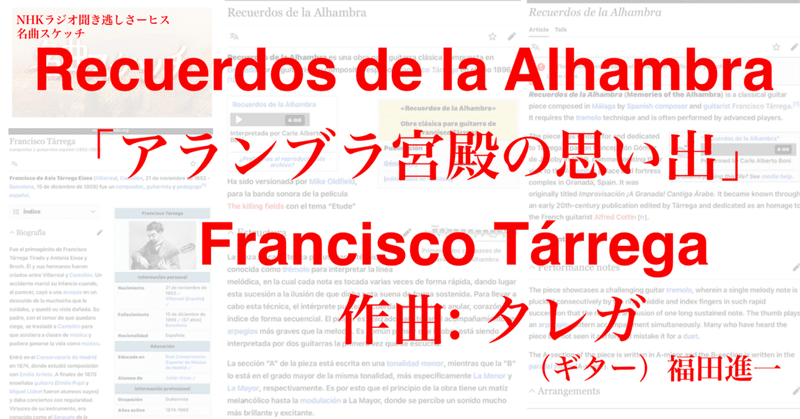
ラジオ生活:名曲スケッチ「アランブラ宮殿の思い出」
聞き逃しサービス 2024/03/08 放送
名曲スケッチ
〜
〜
「アランブラ宮殿の思い出」 ( Recuerdos de la Alhambra )
作曲: タレガ ( Francisco Tárrega )
guiter: 福田進一
〜
開始より00分頃
〜
〜
配信終了 2024/03/15 01:00
(すでに配信終了してます)
番組情報[radiko版]
Google検索 URL>
https://www.google.co.jp/search?tbm=vid&hl=ja&source=hp&biw=&bih=&q=タレガ+アランブラ宮殿の思い出
Bing検索 URL> https://www.bing.com/videos/search?q=Francisco_Tárrega+Recuerdos_de_la_Alhambra
タレガ「アランブラ宮殿の思い出」
Wikipedia JA(日本版)> https://ja.wikipedia.org/wiki/アルハンブラの思い出
〜
『アルハンブラの思い出』(スペイン語: Recuerdos de la Alhambra)は、スペインの作曲家・ギタリストのフランシスコ・タレガによるギター独奏のための性格的小品。原語の発音に近い『アランブラの思い出』という表記も多い。1896年作曲。
高度な演奏テクニックであるトレモロ奏法を活用した曲としても名高く、右手の薬指、中指、人差し指で一つの弦を繰り返しすばやく弾くことによりメロディを奏する。親指はバス声部と伴奏の分散和音を担当する。
クラシックギターでは、アグスティン・バリオス作曲『最後のトレモロ』『森に夢見る』と共に最も有名なトレモロ作品として数えられると共に、スペインにちなんだギター作品では最もポピュラーな作品である。
…
〜[上記wikipediaより抜粋。]
タレガ「アランブラ宮殿の思い出」
Wikipedia EN(英語版)> https://en.m.wikipedia.org/wiki/Recuerdos_de_la_Alhambra
〜
Recuerdos de la Alhambra (Memories of the Alhambra) is a classical guitar piece composed in Málaga by Spanish composer and guitarist Francisco Tárrega. It requires the tremolo technique and is often performed by advanced players.
The piece was written for and dedicated to Tárrega's patron Concepción Gómez de Jacoby in 1899, commemorating their visit to the Alhambra palace and fortress complex in Granada, Spain. It was originally titled Improvisación ¡A Granada! Cantiga Árabe. It became known through an early 20th-century publication edited by Tárrega and dedicated as an homage to the French guitarist Alfred Cottin.
…
【Performance notes】
The piece showcases a challenging guitar tremolo, wherein a single melody note is plucked consecutively by the ring, middle and index fingers in such rapid succession that the result is an illusion of one long sustained note. The thumb plays an arpeggio-pattern accompaniment simultaneously. Many who have heard the piece but not seen it performed mistake it for a duet.
The A-section of the piece is written in A-minor and the B-section is written in the parallel major (A-major).
…
【Arrangements】
Ruggiero Ricci arranged this piece for solo violin and often performed it as an encore.
Chris Freeman and John Shaw recorded the song for their album Chris Freeman and John Shaw (May 1981, EMI Custom Records YPRX 1828, MAC 126).
Nana Mouskouri recorded a vocal version for her 1989 album Classical. Sarah Brightman recorded a re-adapted vocal version for her album Classics.
Alex Jacobowitz frequently performs a version of the song on his marimba and xylophone. He recorded it for several of his albums: Spanish Rosewood (1996), The Art of Xylos (2002), and Aria (2010).
Luiza Borac arranged this piece for solo piano on her 2014 CD "Chants Nostalgiques" (Avie AV-2316).
Xavi Ganjam made a special arrangement for sitar on his EP Soham (2019, Ganjam Records, Spain).
Italian violist Marco Misciagna published the arrangement of this piece for solo viola.
…
〜[Excerpted from above wikipedia]
〜[上記wikipediaの日本語翻訳は次の通り。翻訳にはアプリ「DeepL」を使用。]
Recuerdos de la Alhambra(アルハンブラの思い出)は、スペインの作曲家でギタリストのフランシスコ・タルレガがマラガで作曲したクラシックギター曲。トレモロ奏法が必要で、上級者がよく演奏する。
この曲は、1899年にスペイン、グラナダのアルハンブラ宮殿と要塞を訪れた記念に、タレガのパトロンであったコンセプシオン・ゴメス・デ・ハコビーのために書かれ、献呈された。原題は "Improvisación ¡A Granada"!Cantiga Árabe』というタイトルだった。この曲は、20世紀初頭に出版された、フランスのギタリスト、アルフレッド・コッティンへのオマージュとして捧げられた、タレガ編集の出版物によって知られるようになった。
…
【演奏ノート】
この曲では、1つの旋律音を薬指、中指、人差し指で連続して弾くことで、あたかも1つの長い持続音のように錯覚させるという、難易度の高いギター・トレモロを披露している。親指は同時にアルペジオ・パターンの伴奏を弾く。この曲を聴いたことがあっても演奏を見たことがない人の多くは、二重奏曲と勘違いする。
Aセクションはイ短調、Bセクションは平行長調(イ長調)で書かれている。
…
【編曲】
ルッジェーロ・リッチが独奏ヴァイオリン用に編曲し、アンコールで演奏されることが多い。
クリス・フリーマンとジョン・ショウのアルバム『クリス・フリーマン&ジョン・ショウ』(1981年5月、EMIカスタム・レコードYPRX 1828、MAC 126)に収録されている。
ナナ・ムスクーリは1989年のアルバム『Classical』にヴォーカル・ヴァージョンを収録。サラ・ブライトマンは、アルバム『Classics』にボーカル・ヴァージョンを再録音した。
アレックス・ジャコボヴィッツは、マリンバと木琴でこの曲のヴァージョンを頻繁に演奏している。彼はこの曲をいくつかのアルバムに録音している:Spanish Rosewood』(1996年)、『The Art of Xylos』(2002年)、『Aria』(2010年)。
ルイザ・ボラックは2014年のCD『Chants Nostalgiques』(Avie AV-2316)でこの曲をピアノ独奏用に編曲している。
シャビ・ガンジャムは、自身のEP『Soham』(2019年、Ganjam Records、スペイン)でシタール用に特別編曲した。
イタリアのヴィオリスト、マルコ・ミシアーニャは、この曲をヴィオラ独奏用に編曲して出版した。
…
〜
タレガ「アランブラ宮殿の思い出」
Wikipedia ES(スペイン版)> https://es.m.wikipedia.org/wiki/Recuerdos_de_la_Alhambra
〜
Recuerdos de la Alhambra es una obra para guitarra clásica compuesta en Granada por el guitarrista y compositor español Francisco Tárrega en el año 1896.
Ha sido versionada por Mike Oldfield, para la banda sonora de la película The killing fields con el tema “Etude”.
…
【Estructura】
La pieza se caracteriza por utilizar la técnica conocida como trémolo para interpretar la línea melódica, en la cual cada nota es tocada varias veces de forma rápida, dando lugar esta sucesión a la ilusión de que dicha nota suena de forma sostenida. Para llevar a cabo esta técnica, el intérprete puntea la cuerda con los dedos anular, corazón e índice de forma secuencial. El pulgar es utilizado para tocar el acompañamiento en arpegios más graves que la melodía. Es común pensar que la obra está siendo interpretada por dos guitarras la primera vez que se escucha.
La sección "A" de la pieza está escrita en una tonalidad menor, mientras que la "B" lo está en el grado mayor de la misma tonalidad, más específicamente La Menor y La Mayor, respectivamente. Es por esto que el principio de la obra tiene un matiz melancólico hasta la modulación a La Mayor, donde se percibe un sonido mucho más brillante y excitante.
…
〜[Excerpted from above wikipedia]
〜[上記wikipediaの日本語翻訳は次の通り。翻訳にはアプリ「DeepL」を使用。]
Recuerdos de la Alhambraは、スペインのギタリストで作曲家のフランシスコ・タルレガが1896年にグラナダで作曲したクラシック・ギターのための作品。
マイク・オールドフィールドが映画『The killing fields』のサウンドトラックで「Etude」というテーマでカバーしている。
…
【構造】
この曲の特徴は、トレモロと呼ばれる奏法を用いて旋律線を解釈することである。トレモロでは、各音符が何度も連続して演奏されるため、あたかもその音符が持続しているように聴こえる。この奏法を行うには、奏者は薬指、中指、人差し指の順に弦を弾く。親指は、メロディーより低いアルペジオで伴奏を弾くのに使われる。この曲を初めて聴いたとき、2本のギターで演奏されていると思うのが普通である。
曲の "A "の部分は短調で書かれ、"B "の部分は同じ調の長調、具体的にはそれぞれイ短調とイ長調で書かれている。そのため、曲の冒頭は、イ長調に転調するまではメランコリックな倍音があり、そこからずっと明るくエキサイティングなサウンドが感じられる。
…
〜
Francisco Tárrega
Wikipedia EN(英語版) URL> https://en.m.wikipedia.org/wiki/Francisco_Tárrega Wikipedia ES(スペイン版) URL> https://es.m.wikipedia.org/wiki/Francisco_Tárrega
〜
Francisco de Asís Tárrega Eixea (Villarreal, Castellón, 21 de noviembre de 1852 - Barcelona, 15 de diciembre de 1909) fue un compositor, guitarrista y pedagogo español.
…
【Obras principales y relevancia】
Aparte de sus obras originales para guitarra, que incluyen Recuerdos de la Alhambra, Lágrima, Capricho Árabe, Variaciones sobre la Jota Aragonesa y Danza Mora, arregló piezas de otros autores para este instrumento, como algunas de Ludwig van Beethoven, Frédéric Chopin, Felix Mendelssohn, Franz Schubert y las famosas Serenata Española de Joaquín Malats y La Paloma de Sebastián Iradier.
Como otros de sus contemporáneos españoles, por ejemplo, su amigo Isaac Albéniz, Tárrega tuvo interés en combinar la tendencia romántica que prevalecía en la música clásica con los elementos populares españoles. El conocido guitarrista contemporáneo Angelo Gilardino escribió que los 9 preludios de Tárrega son «... el más profundo pensamiento musical de Tárrega de forma concentrada».
Se considera el creador de los fundamentos de la técnica de la guitarra clásica del siglo xx y del interés creciente por la guitarra como instrumento de recital.
En 2015 el violista italiano Marco Misciagna publicó sus arreglos para viola sola del Tango, Capricho árabe y Recuerdos de la Alhambra.
…
〜[Excerpted from above wikipedia]
〜[上記wikipediaの日本語翻訳は次の通り。翻訳にはアプリ「DeepL」を使用。]
フランシスコ・デ・アシス・タレガ・エイシャ(Francisco de Asís Tárrega Eixea、1852年11月21日カステリョン州ビジャレアル - 1909年12月15日バルセロナ)は、スペインの作曲家、ギタリスト、教師。
…
【主な作品と重要性】
アルハンブラ宮殿の想い出、ラグリマ、アラブの奇想曲、アラゴネサのための変奏曲、モーラの踊りなどのオリジナル作品のほか、ルートヴィヒ・ヴァン・ベートーヴェン、フレデリック・ショパン、フェリックス・メンデルスゾーン、フランツ・シューベルト、ホアキン・マラッツのセレナータ・エスパニョーラ、セバスティアン・イラディエのラ・パロマなど、他の作曲家の作品をギター用に編曲した。
他の同時代のスペイン人、例えば友人のイサーク・アルベニスと同様、タルレガもクラシック音楽のロマン主義的傾向とスペインのポピュラー音楽の要素を融合させることに関心を抱いていた。同時代の著名なギタリスト、アンジェロ・ジラルディーノは、タルレガの9つの前奏曲は「...タルレガの最も深い音楽的思考が凝縮されたもの」と書いている。
彼は、20世紀のクラシック・ギターのテクニックの基礎を築き、リサイタル楽器としてのギターへの関心を高めた人物とみなされている。
2015年、イタリアのヴィオラ奏者マルコ・ミシアーニャが、タンゴ、アラブの奇想曲、アルハンブラの想い出をソロ・ヴィオラのために編曲した作品を出版した。
…
〜
この記事が気に入ったらサポートをしてみませんか?
